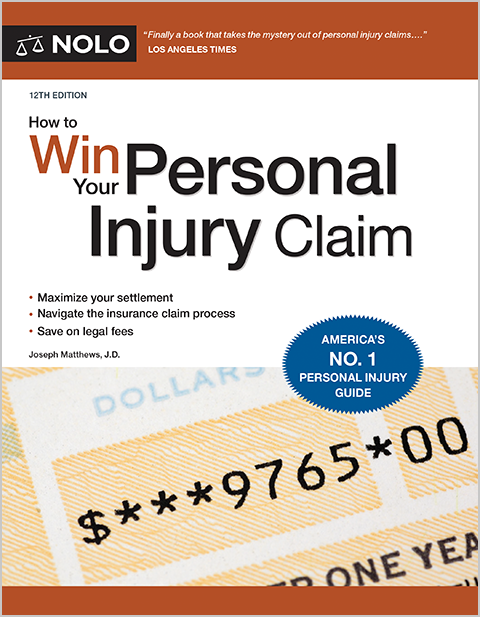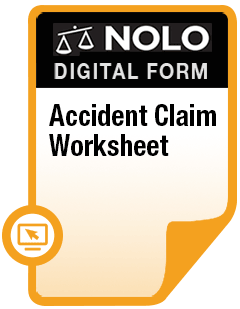Get the details on who to sue, what to sue for, and the kinds of damages you can collect in a defective product case.
You were injured by a dangerous product, and you're thinking about an insurance claim or a lawsuit to recover compensation ("damages") for your losses. But you're not sure about the law. Who should you sue? Are there special legal rules or theories that apply? And if you win, what damages can you collect?
We've got the answers you're looking for, starting with who you can hold responsible for your injuries. We'll also cover the legal theories most often used in dangerous product (called "product liability") cases. We close with an overview of the kinds of damages you can recover should your claims succeed.
Sue All Responsible Parties
The general rule in a product liability case is simple: Sue 'em all and let the court sort it out. As you try to identify parties to sue (called "defendants"), look at everyone involved in the product's chain of distribution—the path the product followed from design to manufacture to distribution to customers.
We discuss several possibilities below. Note that there can be more than one defendant in each category.
Designer
The chain of distribution starts with the person or company that designed the product. The designer might be the same as the product manufacturer, discussed below. Sometimes, though, an independent designer comes up with the initial idea for a product, designs a prototype, and then sells it or contracts with someone else to do the (usually quite costly) manufacturing.
You might not be able to identify all the designers before you file a lawsuit in court. If you learn of others during discovery, you'll need to ask the court for permission to amend your lawsuit to add new defendants, which is common.
Manufacturer
Once the product has been designed and prototyped, it goes to the manufacturing stage. Lots of things can—and do—go wrong here. Some problems are discovered and fixed before the product is sold to end users. But many manufacturing defects don't surface until the product has hit the market and caused injuries.
If the defective component is part of a larger product, you should go after both the manufacturer of the defective part and the manufacturer of the product itself. So, for example, if you were injured by a car with an exploding battery, you would bring your vehicle defect claim against both the car manufacturer and the manufacturer of the battery—along with others in the chain of distribution.
Retailer
The retail store where you bought the product probably didn't manufacture it. But the retailer might still be liable for selling you a dangerous product. Keep in mind that it's not a question of choosing one defendant over another. Any party involved in the chain of distribution is a potential defendant in your lawsuit.
When figuring out if you can sue the retailer, keep in mind that:
You don't have to be the buyer. You borrowed your neighbor's power saw. Because of a defective switch, the saw electrocuted you. You can file a defective product claim against all responsible parties—including the retailer that sold it—even though you weren't the buyer.
You don't have to be the product user. While your neighbor was mowing their lawn, you were injured when a blade flew loose from their defective lawnmower. You might have a viable product liability claim even though you didn't buy the mower and weren't the one using it when you were hurt.
You might be able to sue for used products. You bought a used oven with a defective power cord. The cord caught fire and burned your house down, causing you injuries. Depending on the facts and your state law, you might be able to sue whoever sold you the oven. Talk to a lawyer about the specifics of your case.
Wholesaler or Distributor
In between the manufacturer and the retailer, there can be any number of wholesalers, suppliers, distributors, or other "middlemen." Each one is part of the chain of distribution and might be liable in your defective product lawsuit.
Other Possible Defendants
Your lawyer will be on the lookout for other possible defendants, such as:
- quality-control engineers who failed to spot manufacturing defects
- design consultants who incorporated design flaws into the product, or failed to spot and remove them, and
- for failure to warn or instruct claims, technical experts who wrote the product's instructions for use.
When the Defendant Is a Business Entity
The chain of distribution is certain to include corporations and other business entities. The law probably treats these entities as "artificial persons," meaning they can be held liable just like a natural person. But corporations often change shape, form, and owners via mergers or acquisitions, reorganizations, spin-offs, or re-naming.
Successor companies sometimes assume a predecessor's liabilities for defective products—either by contract or by law. When appropriate, your lawyer will name these successor companies as defendants in your claim.
Kinds of Product Liability
When you sue a driver who runs a red light and hits you, there's probably only one kind of claim you can make. It's called negligence. But in a product liability case, chances are you can bring several kinds of claims. Here are the most common.
Strict Liability
Strict liability is the "ace in the hole" for product liability cases. In a strict liability claim, you don't have to show that the defendant was negligent or otherwise blameworthy when it made or sold the product. You need only prove that:
- the product was defective and unreasonably dangerous
- the product was being used as intended
- you were injured, and
- your injury was caused by the product's defective condition.
Note, importantly, that strict liability doesn't mean "automatic" liability. The defendants can argue that the product wasn't unreasonably dangerous, that you should have been aware of the danger and avoided it, or that the defect didn't cause your injury. But it won't do any good to argue that they were really, really careful when they made or distributed the product, because lack of negligence is meaningless in a strict liability claim.
Deceptive or Fraudulent Marketing
Suppose the evidence indicates a defendant knew (or should have known) that a product was dangerous. But they deliberately concealed the danger, or marketed the product using misleading statements. For example, have a look at this 2018 Reuters investigative report. It suggests that Johnson & Johnson knew for decades about asbestos in talc-containing Johnson's Baby Powder, but continued to sell the product anyway.
While the names vary from one state to another, in a case like this you might have a claim for deceptive marketing or intentional misrepresentation, or a tort claim for fraud. When the defendant is a business entity, what it "knew" can be based not just on someone's memory, but on information found in the company's records.
Breach of Warranty
Many products come with a warranty. A warranty is simply a promise that a product has certain characteristics or will perform as intended with ordinary use. You might have a product liability claim if the defect in your product violated ("breached," in legalese) one or more warranties.
Warranties come in two varieties: Express and implied.
An "express warranty" is any type of warranty or guarantee that's written or stated. Written statements can be:
- on the product's label or packaging
- in the instructions or other paperwork included with the product
- on signs or other marketing materials at the store where you purchased the product, or
- in any form of advertising for the product.
Any of these representations about the product might be an express warranty.
An "implied warranty" is a warranty that the law automatically applies to your product, even if it wasn't expressly stated. State law imposes these warranties on manufacturers and sellers, whether they like it or not. The implied warranties that might apply in your case will depend on the product involved and the circumstances surrounding its sale.
Generally speaking, implied warranties come in two forms.
Implied warranty of merchantability. This is a guarantee that a product will function as intended for its ordinary purpose, and is of like quality as similar products. For example, if you buy a coffee maker that causes a fire when you use it as instructed, that's likely a violation of the implied warranty of merchantability. A correctly designed and manufactured coffee maker shouldn't catch fire when properly used.
Implied warranty of fitness for a particular purpose. When a seller of a product knows that the buyer intends to use it for a particular purpose, this warranty is a guarantee that that product is reasonably fit for that purpose.
For example, imagine you go to the hardware store and ask for a weed trimmer capable of cutting through twigs of a certain thickness. If you're injured because the trimmer breaks while using it for the purpose you specified, you could have a claim for breach of the implied warranty of fitness for a particular purpose.
Negligence
Negligence is the workhorse of the personal injury world. In a nutshell, it means a failure to act as carefully as would a reasonable person under the circumstances. In product liability cases, the three most common negligence claims are negligent failure to:
- properly design the product
- properly manufacture the product, and
- warn or instruct about safe use of the product.
Proving negligence can be a challenge. The degree of difficulty will depend on the type of product and the design, manufacturing, and distribution processes involved. For example, showing that a huge pharmaceutical manufacturer's quality-control engineers failed to exercise reasonable care might be impractical. On the other hand, it probably won't be as difficult to prove that a scooter dealer failed to inspect the brake pads on scooters it sold.
Damages in a Product Liability Case
"Damages" is the legal term for money paid to the injured party (the "plaintiff"), either to compensate for losses stemming from an injury or illness, or to punish the defendant for extreme misconduct. In a personal injury lawsuit, damages might refer to:
- amounts a judge orders a defendant to pay after a trial, or
- compensation paid to a claimant via a personal injury settlement.
All damages fall into two basic categories: Compensatory and punitive.
Why Understanding Your Damages Is Important
Damages are a critical element of your product liability case. Without them, you don't have a claim. Without enough damages, it might not make sense to spend the time and money to pursue your claim. In addition, the smaller your potential damages, the less likely you are to find a lawyer to represent you.
There's one situation when small individual damages might not be a barrier to bringing your claim. If you're injured in a mass tort—meaning by a dangerous product that injures thousands of people—it might be possible to pursue your case, along with all others, as part of a class action or multidistrict litigation.
Compensatory Damages
Compensatory damages (sometimes called "actual" damages) compensate you for injury or illness caused by a dangerous product. The idea is to restore you—as much as possible—to the condition you were in before you were hurt or got sick. Compensatory damages do this by attaching a dollar value to each of the bad things that happened when you used the product.
There are two categories of compensatory damages: Economic damages and noneconomic damages.
Economic Damages
Economic damages, also called "special damages," reimburse you for losses that come out of your (or your insurance company's) pocket. Here are some common examples.
Medical expenses. Included here are past and future expenses for doctors, hospitals, medications, therapists and other necessary care.
Costs of disability. When disability caused by a dangerous product requires you to change your lifestyle, you're entitled to be paid for the costs of making those adjustments. Examples include amounts you pay others to perform household chores, and the costs associated with renovating your home to accommodate, say, a walker or wheelchair.
Lost wages or income. If you miss work (or are expected to miss work in the future) because of your injury or illness, you'll want to include a demand for lost wages. When your livelihood depends on your business income, you can be compensated for lost profits.
Property loss or repair. You're entitled to the costs of repair or replacement when a defective product damages or destroys your property.
Noneconomic Damages
Noneconomic damages, sometimes called "general damages," compensate for losses that are more difficult to quantify and that aren't paid directly out of your pocket. Pain and suffering, emotional distress, loss of enjoyment of life, and loss of consortium are among the most common examples.
Punitive Damages
Compensatory damages try to make you whole after an injury or illness. By contrast, punitive damages are designed to punish a defendant's outrageous conduct, and to deter similar behavior by others in the future. Punitive damages aren't unusual in high-profile, mass product liability cases. Outside that context, though, they're fairly rare.
Here are a couple of noteworthy cases:
- In 2020, a New Jersey jury ordered Johnson & Johnson to pay $750 million in punitive damages (later reduced to $186.5 million) to four plaintiffs who alleged that asbestos-tainted baby powder caused their mesothelioma, and that J&J hid from the public the fact that its product contained asbestos.
- In 2019, a jury ordered Roundup manufacturer Bayer to pay $2 billion in punitive damages to a couple who both developed non-Hodgkin's lymphoma after using Roundup for over 30 years (the plaintiffs' total award was later reduced to $86.7 million). Learn more about Roundup-cancer lawsuits.
Getting Help With a Product Liability Claim
There's no such thing as a "simple" product liability claim. Any product liability lawyer will tell you they're among the most difficult and expensive of all personal injury cases. The costs to design, make, and sell products mean that product manufacturers and sellers have a lot on the line. Bad publicity associated with a big product liability case can mean financial disaster.
For these reasons, expect a vigorous defense to your product liability case. You'll face experienced product liability defense attorneys who know all the tricks of the trade, and who specialize in making quick work of unrepresented plaintiffs. Long story short: You don't want to venture into this territory alone.
When you're ready to move forward, here's how to find an experienced product liability lawyer to guide you through the process.
Talk to a Lawyer
Need a lawyer? Start here.
How it Works
- Briefly tell us about your case
- Provide your contact information
- Choose attorneys to contact you
- Briefly tell us about your case
- Provide your contact information
- Choose attorneys to contact you


